Ever wondered what would win if a Tank went to head-to-head with a Daddy Long Legs? Probably not.
![]() Before we go any further, let's first clarify what a "counterbalanced" putter is.
Before we go any further, let's first clarify what a "counterbalanced" putter is.
In order to improve the stability and forgiveness of a putter, manufacturers use weights in the shaft and/or the grip of a putter. Unlike an anchored putter, which relies on the putter being anchored to something stationary (i.e. your belly or chest), by altering the weight and increasing the MOI of a putter, a counterbalanced putter allows you to independently find a stable, more reliable stroke.
Counterbalanced putters are designed to be gripped-down, meaning you leave 2 or 3 inches of grip above where you grip the club to help enable that counterbalancing performance.
Don't believe the hype? Well here what the reps from TaylorMade and Odyssey told me:
“The higher the head’s MOI, the more resistant it is to twisting on off-centre hits, helping you roll the ball your desired distance, and on your desired line, on mis-hits." - TaylorMade's Brian Bazzel
"At every golf club in the world, we've heard golfers say, 'I just want something a little heavier. With the proposed anchoring ban in discussions, we thought it was the right time to service golfers with an alternative and stability-focused method to putting and putter design." - Odyssey's Chris Koske.
You may be forgiven for believing that counterbalancing, like anchoring, is a new fad. In fact, counterbalancing golf clubs and especially putters has been going on for yeras. Golfalot's Mart Hopley dabbled in counterbalancing in St. Andrews several years ago.
Now, back the battle.
Let's take a look at the two heavyweight competitors and their stats:
Odyssey Tank
Material: Steel
Length: 40 inches
Lie: 70°
Loft: 3°
Head Weight: 400 grams
Grip Weight: 60 grams
Insert: White Hot
RRP: £139
TaylorMade Daddy Long Legs
Material: Multi-Material
Length: 38 inches
Lie: 70°
Loft: 2.5°
Head Weight: 395 grams
Grip Weight: 130 grams
Insert: PureRoll Suryln
RRP: £159
Having been a player who has switched his putter often, I have a good idea of what I look for in a putter. It comes down to four components: look, feel, performance and cost. Seen as both these putters retail from anywhere from £130 to £160, I set about evaluating based on the other aspects.
Looks
Both the Tank and Daddy Long Legs have oversized heads designed to draw weight away from the face and further improve the feel and forgiveness of the putter.
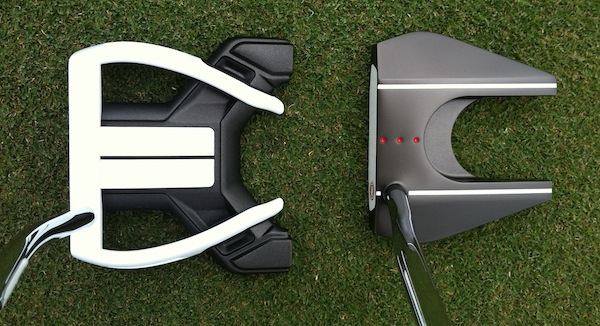
The Tank comes in Odyssey's popular #7 head design. The fang-like shape pulls away from the leading edge in order to create forgiveness right across the face. The dark finish was a little lighter in person than in photos, but looks very strong behind the ball and gives an armour-like look that plays into the Tank name.
I found the Tank sat slightly upright for my set-up, however I'm assured it, like most putters, has 70° of lie angle.
Personally I prefer the single white line alignment aid on the White Hot Pro and Metal-X versions of the #7. The Tank, like the older White Ice model, features the triple dot design. Overall the shape is a proven winner with amateurs and pros, and I am a fan of it too.
As you would expect with a name like Daddy Long Legs, the TaylorMade putter has a little more going.
The performance mallet has a lot of parts, quite literally. 16 different pieces made from 8 different materials create the unique look. I, like many, saw photos of this and thought it looked more suited to a sci-fi movie than a putting green, but once I put it behind the ball, it just worked.
I got the chance to try and enjoy the previous model, the Ghost Spider S, with Peter Hanson last year in St. Andrews. However, the improvements TaylorMade have made on the Daddy Long Legs have made it even more appealing on the eye.
The long, straight, white leading edge is extremely easy to align. The face is slightly longer than the Tank, but with its white colour, it appears even larger. The black alignment line is a nice touch, and the rest of the high-MOI design somehow blends into your view at address.
Both are unique designs, and whilst Old Tom Morris would likely faint if he were to see either of them behind his ball, I liked both. Ultimately I found the look of the Daddy Long Legs easier to align and more inspiring at address.
Feel
This is the real test for the counterbalanced putters. They are carefully designed to promote stable and forgiving performance, with a feel similar to a conventional putter.
That statement is 50% accurate in my mind.
Both felt extraordinarily stable and forgiving, but neither felt like a standard or traditional length/weighted putter.
Take one putt with the Tank and you immediately hear the dull, blunt feel off the newly improved White Hot insert. Over and over, it felt very much like it looked; strong, heavy and blunt.
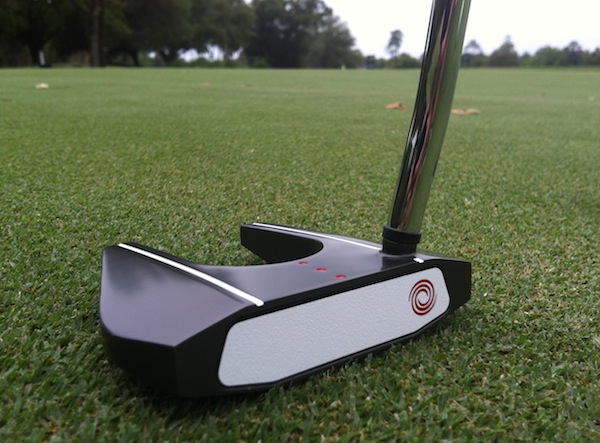
The 400g weight of the Tank's head was not overwhelming, it simply worked to help guide the path of the putter head.
The TaylorMade Daddy Long Legs felt slightly different. With all the parts in the head working together, the feel was more hollow and slightly softer (still firmer than conventional putters).
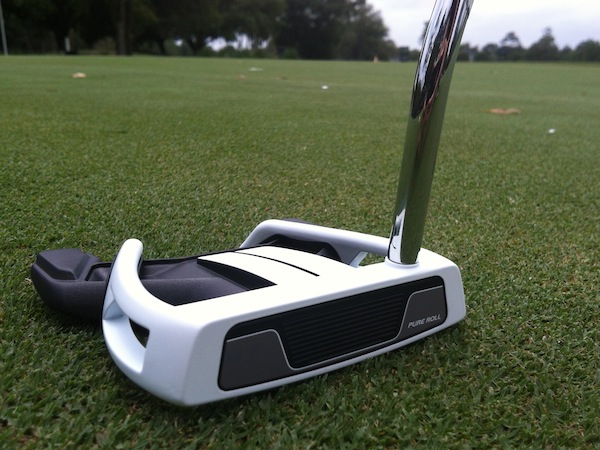
To say it has more of a plastic-feel is not to downgrade the Daddy Long Legs, I believe it just plays into the fact that more parts are at play and the weight is positioned further back.
Overall, I found the feel of the Tank to be more what I was expecting and preferred. It felt very strong, yet dull, and if someone asked me to close my eyes and think of how a putter named the Tank might feel, that is pretty much exactly what I felt in my hands.
Performance
Ultimately, like any shot in golf, it can look and feel great, but if it doesn't end up where you intended it to go what use is it really? To measure the performance, I hit approximately 50 putts from 3, 7 and 15 yards with both putters, twice.
Following the first putt with the Tank, I proclaimed our loud "wow, that's amazing". A simple pendulum action produces a stable, smooth roll that had that going-in feel immediately from impact.
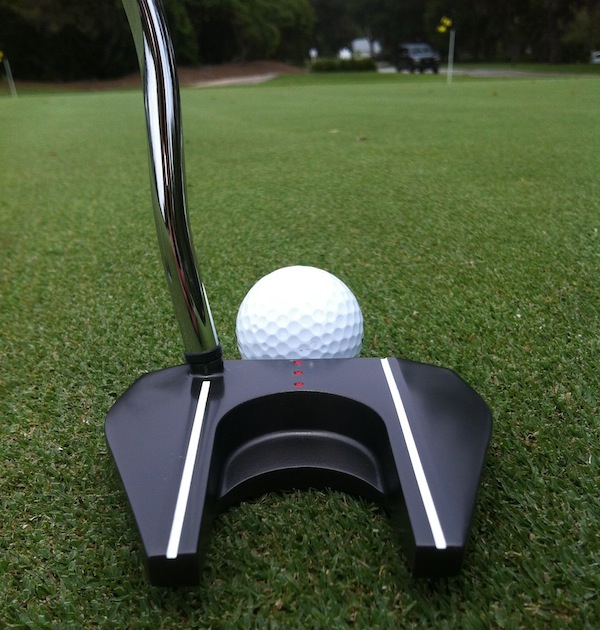
From all ranges, the Tank was extremely consistent. The more I putted with it, the more I could feel the design help guide me on how to use it properly. Light grip, smooth stroke, more emphasis on the forearms and shoulders than the fingers and wrists. Very impressive.
The extra pop you get from the added weight and size was evident on mid and long range putts.
Unfortunately for the purpose of choosing a preferred putter, the TaylorMade was equally impressive. The Daddy Long Legs sets up so easily that when you see the short putts going in time-after-time, you wish it was Club Championship week.
The PureRoll Surlyn insert grooves only cover about 50% of the face. Of course what came to my mind was "I bet the forgiveness on the outer edges is impaired". I could not be more wrong.
Actively trying to hit the ball from the heel and toe of the putter made little impact on the results as putt after putt rolled towards the hole. It is truly amazing how little impact a mishit has on distance control.
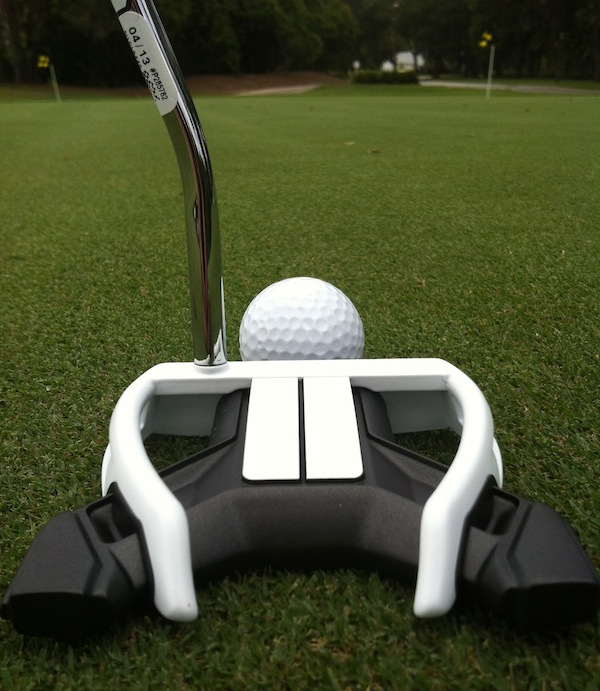
The Verdict
It's not easy to find weaknesses in both models. Both are designed to pull weight away from the head, and with their added counterbalancing, the performance is extremely stable and solid.
Both inserts offer a slightly different feel and sound. The tank was more of a metallic sound and feel which surprised me as growing up around Odyssey putters, I always considered their inserts to be the softest in the market. The softer TaylorMade insert is very easy at impact. but feedback isn't quite as strong.
It would be easily of me to say both were equally impressive in performance tests, but for the simply reason I was marginally more consistent overall and holed more, I had to give the nod to the Odyssey Tank.
So there you have it, who wins when you put a Tank head-to-head with a Daddy Long Legs? In this case, the Tank does.
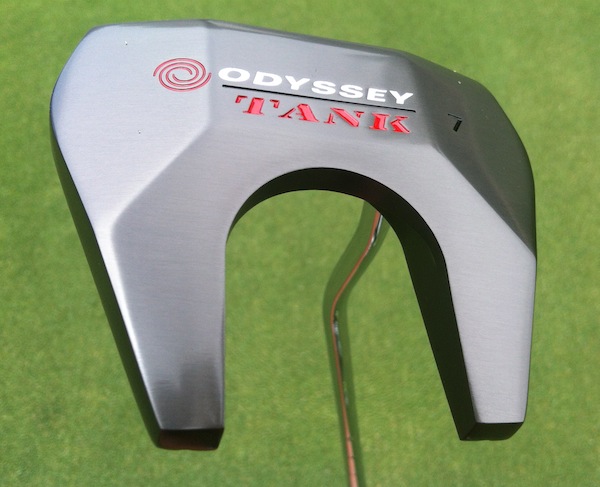
I recommend anyone, of any handicap, that struggles on the greens to at least test a counterbalanced putter. For me, I didn't appreciate the benefit until returning to my normal Anser-shaped blade putter. Controlling the leading edge and pace on all putts is just more of a challenge.
If you are a touch putter that relies on the specific feel of a trusted putter, I salute you and excuse you from mandatory enrollment in counterbalance putter school. For all others, I liken the gains to trying a game-improvement iron over a hard to hit/control blade iron.
Did you know 14-year old Gianlang Guan used a counterbalanced Odyssey Tank putter at the Masters? Amazingly he navigated the four days without a single three-putt, one of only two players to achieve the feat.
Ultimately the easier you make the game, the better you'll score and the more you'll enjoy it. Counterbalancing on the greens may just do that for your game.
Facebook Comments